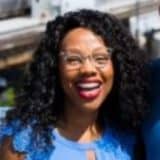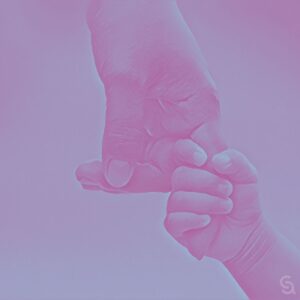
There is such a stark contrast between the two regions that one might easily, though erroneously, be lured into the deceptive ease of seeing only two worlds: that of Israel and Israelis, and that of Palestine and Palestinians. But if we allow ourselves to wonder, to be curious about the worlds nestled betwixt and between these two nations, we get to witness the subtle nuances, the complexities, even the ironies that live in the in-between.
And as is often the case, both the truth and that which commands our attention, our agency, lies within the gritty nuances that we get to witness if only we courageously, selflessly, and faithfully practice proximity—getting close enough to the people and their places, their stories, to smell the scents, savor the flavors, endear the hearts, and share both the salt of their tears and the sweetness of their joy.
It was in those grainy, bittersweet nuances that I heard the story of “Muhammad.” After a love-laden meal of Makloubeh, this bronzed man of meager means invited us to the rooftop of his home. In the stillness of the air, mocking the turbulence of this conflict-ridden land, we sat, drinking water and tea. And after a bit of reflective silence, Muhammad began.
Through the roughness of his voice, the vehicle over the course terrain of his life’s stories, Muhammad spoke of a climate that demanded sacrifices of home, health, and family that I could not begin to imagine. A Palestinian man who graciously fed me, a Christian-American woman, simultaneously spoke of how religious leaders associated with my faith tradition and my nation participated in the funding of expansion projects that brought the edge of Israel and militarism right up to the welcome mat of his home.
Faced with the choice of taking a million dollars and relinquishing the rooftop we stood on (and, more significantly, the family legacy held by the home underneath) or refusing it, cementing himself in material poverty for life, Muhammad chose the latter, stating that it was not just for the preservation of his own home, but also for all of the Palestinian dwellings and families therein who would become susceptible to even more militarism and national policing if the Israeli border were advanced. The clear-cut responses to who is right and who is wrong became dust, floating in the stillness of the rooftop air.
The clear-cut responses to who is right and who is wrong became dust, floating in the stillness of the rooftop air.
My certainties whirled around all the more in the afternoon breeze when I visited Al Ibrihimi Mosque. Considered sacred ground for practicing Muslims in the region, particular procedures and protocols are in place here. Half the building is a synagogue, and the other half a mosque. Neither is allowed on the other side, other than a few times a year when one group gets the entire space to worship.
Another protocol that is strictly encouraged in the mosque is for all visitors to “back out,” or walk backwards out of the space, so as never to turn one’s back to the most sacred space for worship. Jews are not permitted in this Muslim half of the space, yet while I was there, I witnessed a group of Israeli Jews, accompanied by half a dozen armed military soldiers, embark upon the space, walking and talking amongst themselves, and, upon their departure, exit with their backs to the mosque. I share this account specifically to highlight the antagonistic nature of the act, but I would be remiss to ignore the ever-pervading presence of military presence and constant body policing taking place in the region.
Israelis express the need for such military presence due to concern for their safety from Palestinians. Palestinians assert that it is used to subjugate and oppress them, even on their own land. In either case, the extreme presence of militarism in the region has severe consequences for the youth.
This became markedly clear to me one afternoon when I was having ice cream with three of my colleagues in a public square in Jordan. As we sat on concrete stairs, delighting in the warmth of the sun and the sweetness of our treats, military presence at all four corner towered above the space. A little boy, dark-haired and chubby-cheeked, not yet old enough to have even mastered the art of bike riding without training wheels yet, was holding a toy gun—semi-automatic in its semblance. As people walked to and fro, coming and going from the doors of the Damascus Gate in the Old City that leads to the market, this young one would choose his target, take aim at the person of his choice, and with laser-like focus, pull the toy trigger, letting off the sound of rounds, rapid fire.
Days later, we met a young man carrying out the two-year tour of duty mandated for all post-secondary Israeli teens, irrespective of gender or desired future concentration of study. As he approached our group, machine gun slung listlessly over his still-adolescent shoulder, he greeted us with a somewhat sheepish smile. The disorienting juxtaposition of the violence and tenderness in his posture stopped me in my tracks; consequently, much of the conversation he shared with other members of our group was distorted for me at best.
My location in the world is such that approaching a white man with a semi-automatic weapon, smiling or not, could cost me my life. Nevertheless, what I did register was his naming of the challenges and difficulties of maintaining his own peace-making nature, while fully embodying his role as a soldier as well. This was one of the many, countless times during my stay that the complex nature of the conflict engulfed me, made me register the air around me, made me feel it was too thin to breathe.
I had moments so full of life and joy that I was perplexed by the extent to which joy was possible in a context so wrought with strife.
And while there were too many of those moments, there were also moments so full of life and joy that I was perplexed by the extent to which joy was possible in a context so wrought with strife. One example was when a Palestinian Christian family hosted us for dinner in their home. Again, the hospitality was overwhelming! We ate and drank well, but beyond that, the singing and dancing we shared in the warmth of their backyard on that spring evening was a time I am unlikely to ever forget. We shared that time in a yard that was literally intersected by “the wall,” a very present character in the narrative we were weaving together, complete with rusted barbed wire atop, reminiscent of a crown of thorns. Yet we still managed an unprecedented joy and resilience that is only born from the depth of overcoming.
Another witness of similar resilience occurred when we visited the Tent of Nations. Family-owned for decades, the Nasser family told us of the many escapades they had experienced as Israel attempted to snatch land in the region. Several court bouts and crop contaminations later, this land now hosts hundreds of volunteers annually who come bearing ecological, environmental, and agricultural gifts to ensure the farm’s continued sustainability. It was there that we ate from the land and celebrated the fruits of the labor, both literally and figuratively.
Our time in Israel was marked by these small signs of light and hope. It was there that we heard the inspirational narrative of two collaborators, one of Israeli descent who had lost his daughter in a terrorist attack on her office building, and another, an American expatriate who had lost her husband, a man of Palestinian descent, at the hand of the Israeli military. Together, these two individuals are working to gather people from both regions who have suffered the loss of a loved one as a direct result of the Israeli/Palestinian conflict, to let what they have in common–shared grief as a consequence of the conflict–bring them together to form a greater sense of peace and community. Such a profound witness of reconciliatory activism!
It was also in Israel that we met a rabbinical professor who introduced us to the concept of Makhloket. This traditionally Jewish form of debate or conflict resolution requires its participants to include that which is good and valuable from the counterpoint into what one espouses as their position in the debate. This tradition necessitates each participant to consider another’s perspective deeply enough to extract that which is relevant and beneficial from the counter perspective. Therein seems to lie implicit grace and solidarity, elements seemingly otherwise so distant from this conflict.
As I prepared to depart from the region, I felt as though I would have been remiss to have peered into the lives of so many without leaving with a concrete goal. I left with a self-imposed mandate, one which could actually be carried out: to share with as many people as I can the complex realities of the Israeli/Palestinian conflict, and the need for us to get close enough to the people and places impacted by the struggle that we can personally attest to the nuances of the narrative.
This is my challenge to you, the reader. Stretch yourself to be curious, and wonder more deeply about the conflict that is unfolding in this region. Seek out the complexities of their holistic and collective narrative. And allow yourself to respond to whatever call may ensue.
Selah.
 Reesheda Graham-Washington is the executive director of Communities First Association, a national faith-based nonprofit committed to asset-based community development, and the founder and CEO of L!VE Café, a boutique coffeehouse that focuses on transformation. A resident of Berwyn, Illinois, she shares her heart for service with her husband and three daughters.
Reesheda Graham-Washington is the executive director of Communities First Association, a national faith-based nonprofit committed to asset-based community development, and the founder and CEO of L!VE Café, a boutique coffeehouse that focuses on transformation. A resident of Berwyn, Illinois, she shares her heart for service with her husband and three daughters.


